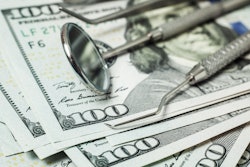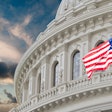Washington, D.C. -- Lori Paulson came to the Dental Trade Alliance’s Washington Policy Summit for some guidance on how tariffs impact her current business model and how long she may be dealing with the uncertainty of what comes next for her customers.
Paulson, National Distribution and Contracting (NDC)’s chief commercial officer for dental and specialty markets, has had questions flood in from not only her manufacturer partners but their customers as well.
“It’s very challenging, and part of the reason is the volatility and the frequent fluctuations in trying to anticipate how we need to stock our product and provide products for our distributors,” Paulson said. “The issue of pending tariffs and then a pause and then potential reverting of the tariff is making it very difficult for us to anticipate demand levels on those products.”
Founded in 1953, per its website, NDC has evolved from a small buying cooperative of independent healthcare distributors into a unique healthcare supply chain company. That evolution now includes looking to President Donald Trump and his administration to determine what tariffs on products made outside the U.S. will be in effect permanently.
Paulson said NDC is currently basing any price increases that are passed along to the customer on the tariff’s proposed implementation date, even if the tariff is lowered at the last moment.
“We have to follow that increase on that implementation date because of the impact of inventory and our future replenishment costs,” Paulson said. “If the tariff is reverted, we again have to evaluate our inventory positions based upon what cost we acquire the product for, and that is where it’s very difficult to particularly manage at a SKU level or an item level.
“The challenge becomes if demand changes based upon the distributor or the dental office looking at an alternative product that might not have the tariff. With that, how do you manage inventory and demand?”
Paulson made it clear that with any potential price increases, NDC is following the manufacturer’s pricing initiatives.
“We’re following the manufacturer, so if that manufacturer indicates May 1 is the date or June 1 is the date or they’re pausing and evaluating, we are following that guidance from the manufacturer,” Paulson said.
Paulson hoped to gain a bit of clarity during the summit in Washington, which was followed by a day on Capitol Hill meeting with senators and representatives from each DTA member's respective state. She believes her company and the rest of the dental industry need a clear understanding of exactly what tariffs will be in place so businesses can plan for the rest of the year and beyond.
“I think we have to have some stability,” Paulson said. “I understand the objective of the tariffs, which, my understanding is, that it’s to be proactive with USA-made goods and to ensure that USA-made manufacturers are on a level playing field.
“However, it’s very difficult to flip on a dime and to convert business or manufacturing that has been moved out of the country to have it come back into the country. I think there’s a short-term gap that will really become a struggle for every consumer in America, and the impact on healthcare has to be a concern for all of us, including dental care, medical care, and healthcare overall, because you can’t flip that (production) in a short period of time.”
Meanwhile, Brant Herman, CEO and founder of MouthWatch and Dentistry.One, was at the DTA summit to not only learn about tariffs but also about potential cuts to Medicaid and how that could impact the dental industry.
“We’re in a different spot as a company, which is interesting, because one side of us is really focused on, especially at this event, the key issues of preventive care and of Medicaid access, because a lot of our software and our telehealth solutions orient toward that,” Herman said. “We’re also a manufacturer of imaging hardware, where we import components that are very hard to source in the United States. Even with some domestic manufacturing, the component part comes from overseas.”
Herman said he came to the event not only to learn what information he could in Washington but also to partner with his industry colleagues from around the nation.
“We’re here to collaborate with and better understand industry partners, and that’s not so much the dentist or the practice group, where we really spend a lot of time trying to understand the goals and considerations,” Herman said. “Here, it’s about our shared concerns as an industry. What does the rest of this year hold, and how are all of our businesses going to pivot and continue to provide what our customers need?”
While hot-button issues took the forefront during the gathering in Washington, Herman was quick to point out that there are still underlying issues in dentistry that need to be solved as well.
“I do think we are in a global trade economy, and I don’t think a lot of this (manufacturing) can immediately shift in two or three years,” Herman said. “But there’s still the matter of staffing shortages and reaching vulnerable populations in areas where dentistry is currently lacking that we simply can’t forget about as well.”



















